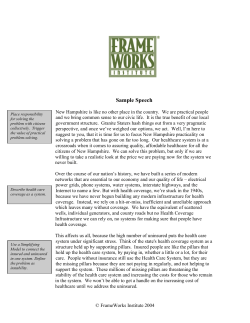
Document 3614
Why Do We Need the Affordable Care Act? Critical health system problems facing the United States August 2012 There are numerous reasons health reform is critically needed in the United States, including: Too many people lack health coverage. •In July 2012, the Congressional Budget Office estimated that 55 million Americans under the age of 65 are currently uninsured; representing 1 out of 5 in that population. Most of the uninsured go without health coverage because they can’t afford it, and they would purchase it if they could. •The uninsured are less likely to receive preventive care, and less likely to seek care as quickly when they are sick or injured. This results in higher costs when they do seek treatment. In addition, nearly 40 percent of the health care costs of the uninsured are passed on to consumers who do have coverage, in the form of higher premiums. According to Families USA, this costs each family with health coverage more than $1,000 a year. U.S. healthcare spending is unsustainable. •Health care spending represented 17.9 percent of our gross domestic product (GDP) in 2010, and is expected to reach 20 percent by 2020. Medicare alone accounted for 15 percent of our federal budget in 2011, and absent reform, this share is expected to grow as the baby boom generation continues to retire. •Rising health care costs both contribute to our federal deficit and reduce our ability to spend in other important areas including education, housing, and economic development. And the high costs of health care directly impact businesses and consumers: both the family and employer shares of employer-based coverage doubled from 2001 to 2011. Despite high spending, our health outcomes are poor. Our system emphasizes treatment instead of prevention. Health disparities exist among numerous populations. •The U.S. spends far more on medical care than any other industrialized nation, but ranks 24th among 30 OECD countries in terms of life expectancy. The Institute of Medicine reported in 2012 that “the current generation of children and young adults in the United States could become the first generation to experience shorter life spans and fewer health years of life than those of their parents.” •Today, seven in ten deaths in the U.S. are related to preventable diseases such as obesity, diabetes, high blood pressure, heart disease, and cancer, and three quarters of our health care dollars are spent treating such diseases. However, only 3 cents of each dollar spent on health care in the U.S. (total public and private) go toward prevention. •Health inequities related to income and access to coverage exist across demographic lines, but population-based disparities are impossible to deny. For example, as reported by Families USA, “African-American women have the highest death rates from heart disease, breast and lung cancer, stroke, and pregnancy among women of all racial and ethnic backgrounds” and “Hispanics had poorer quality of care than non-Hispanic whites for about 40 percent of quality measures, including not receiving screening for cancer or cardiovascular risk factors.” The Affordable Care Act won’t solve all of these problems overnight, but it’s an important step forward. By making health coverage more affordable and accessible and thus increasing the number of Americans with coverage, by funding community-based public health and prevention programs, and by supporting research and tracking on key health measures, the ACA will begin to reduce disparities, improve access to preventive care, improve health outcomes, and reduce the nation’s health spending. Learn more (and find this document, with source links) at http://www.apha.org/advocacy/Health+Reform/ACAbasics/.
© Copyright 2025





















